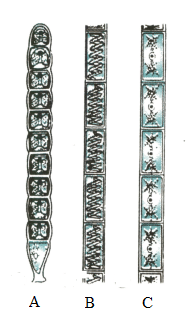HARD
Earn 100

Identify and describe Ulothrix algae from given figures.

Important Questions on Diversity in Living Organisms
MEDIUM
MEDIUM
EASY
MEDIUM
EASY
EASY
MEDIUM
EASY
EASY
EASY
EASY
EASY
MEDIUM
EASY
Reason: Each group of algae show predominance of one pigment.
EASY
(1) Pyrenoids (2) Ribbon like chloroplast (3) Filamentous structure;
Which organisms has he observed?
HARD
| Column-I | Column-II | ||
| A. | Phaeophyceae | I. | Funaria, Polytrichum, Sphagnum |
| B. | Rhodophyceae | II. | Equisetum, Psilotum, Pteris |
| C. | Mosses | III. | Ectocarpus, Dictyota, Laminaria |
| D. | Pteridophytes | IV. | Polysiphonia, Porphyra, Gracilaria |
MEDIUM
Which among the following have specialised tissue for the conduction of water?
(i) Thallophyta
(ii) Bryophyta
(iii) Pteridophyta
(iv) Gymnosperms

